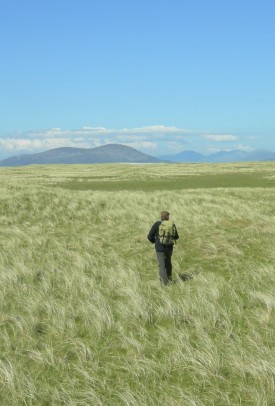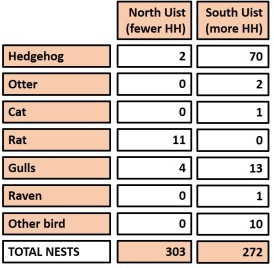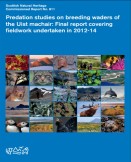Spoiler alert – hedgehogs are the killers

Hedgehogs – an unwelcome addition to the unique machair habitat (Photo: John Calladine)
The chain of Hebridean islands from the northern tip of North Uist to the southern tip of South Uist are special places to visit in the summer. Nowhere else in the UK will you find higher concentrations of breeding waders. In 1983, Fuller et al. estimated that this region held a third of the UK’s breeding Dunlin and a quarter of its Ringed Plover. (Populations of breeding waders and their habitats on the crofting lands of the Outer Hebrides)

Photo: Graham Catley
The islands are still special but, as a consequence of the spread of hedgehogs, following the introduction of just seven individuals in 1974, numbers of breeding birds have dropped dramatically. The addition of this extra predator, which can feed by day and night and possesses a coat of spines that can withstand aerial attacks by parent birds, has long been associated with the decline. But how much of the blame lies with the hedgehog and what can be done to support wader populations?
Brief history

A quarter of the UK’s breeding Ringed Plover nest within the Outer Hebrides (Tómas Gunnarsson)
The Outer Hebrides, in north west Scotland, used to be a haven for breeding waders, many of which nest on machair, fertile coastal grasslands along the west coast. It’s a mosaic of habitats that includes arable and pastoral farmland, pools and sand dunes. The waders that nest here have been subject to predation, from gulls, corvids, rats etc. but the hedgehog was an unwelcome addition. With no foxes or badgers to eat them, no fleas to carry diseases and a good supply of easily-accessible eggs, hedgehogs have thrived and spread.
Work in 1998, led by Digger Jackson, showed that the hatching success for Dunlin, Lapwing, Redshank and Snipe clutches was 2.4 time higher in areas from which hedgehogs had been excluded. This was published in the Journal of Applied Ecology in 2000.
Breeding waders were surveyed in 1983, when hedgehogs were restricted in their distribution to small parts of South Uist. By the time of the next extensive survey in 2000, hedgehogs were well-established across South Uist and Benbecula, and the first individuals had reached the southern end of North Uist Uist. In just 17 years, numbers of breeding waders declined by 39% in the areas with hedgehogs, while there was an increase of 9% in North Uist. There were differences for all wader species but particularly for Redshank and Lapwing. The results were published in Biological Conservation in 2004. A subsequent control programme, to assess whether eradication might be a practical option, was expected to arrest the decline in wader numbers and promote recovery. Sadly, population levels have not recovered as well as expected which begs the question – ‘are hedgehogs the only problem?’
Further large-scale surveys were carried out in 2007 and 2014

Rob Fuller, walking a transect (John Calladine)
The 2007 survey is written up in Bird Study. (Changes in the breeding wader populations of the machair of the Western Isles. Scotland, between 2000 and 2007).
The 2014 survey is written up in Scottish Birds (Calladine, J., Humphreys, E.M. & Boyle, J. (2015). Changes in breeding wader populations of the Uist machair between 1983 and 2014. Scottish Birds 35: 207-215).
In the period between 1983 and 2014, the greatest overall proportional declines were of Dunlin and Ringed Plover (72% and 70% respectively). Snipe declined overall by 45% and Lapwing by 14% while, in contrast, Redshank increased by 8% and Oystercatcher by 74%. The changes were not the same in the zones with and without hedgehogs. The deviation in trends was most marked for Redshank (which increased by 91% in the northern zone, with fewer hedgehogs, while decreasing by 22% in the southern zone) and Snipe (much bigger decreases in the south). Dunlin and Ringed Plover declined markedly in both zones, though less so in the northern zone. Any difference in trends was less apparent for Lapwing, although it did appear that they may have fared less well in the southern zone.
Are hedgehogs the main problem?

A hedgehog ignores nest defence efforts of pair of Lapwing (screen-grab from SNH surveillance camera)
A report, prepared for Scottish Natural Heritage by a consortium comprising the British Trust for Ornithology, the James Hutton Institute and MacArthur Green Ltd., aims to quantify the importance of predation by hedgehogs, relative to that by other predators. The report includes a summary of the changes in numbers for the various wader species during a forty-year period, based on occasional broad-scale surveys and more regular monitoring of specific study sites. The focus, however, is on results from studies using nest cameras, temperature loggers and fixed point observations in the 2012, 2013 and 2014 breeding seasons, measures of disturbance, transect work to assess productivity, and some land use and habitat recording.

A hedgehog in the half-light (John Calladine)
The principal aim of the study was to quantify the importance of predation by hedgehogs, relative to that by other predators, work that could support arguments in favour of continued and enhanced removal of these introduced predators. Cost-effective solutions may require lethal control, instead of or in addition to translocation. These are tricky decisions, especially when considered alongside the rapid decline in numbers of hedgehogs across much of the UK.
Main findings

Clutch survival rates
The latest study provides further evidence that predation by hedgehogs is having an ongoing impact on breeding success of wader nest on the Uist machair, at least some of which is additional to that of gulls, which take both eggs and chicks.
In North Uist (low density of hedgehogs) clutch survival rates were higher than on South Uist (high density of hedgehogs) for the four main study species – see table. Overall, in North Uist, 74% of

Confirmed and probable causes of predation
wader nests, where outcome was confirmed, successfully hatched chicks. In South Uist only 45% of nests successfully hatched chicks. Most observed losses in both areas were due to predators.
Hedgehogs were the most numerous nest predators identified using nest cameras and other evidence, accounting for over half of occurrences, with all confirmed instances of predation by hedgehogs occurring in the ‘high hedgehog density’ areas. In these high density areas, hedgehogs were responsible for 35% of nest failures. Although summer nights are shorter than in much of the UK, 45% of clutch incubations ended during darkness in high hedgehog density areas, compared to 29% in low density areas, again suggesting that mammals are the main predators, with hedgehogs the most likely culprits.

This Common Gull takes an egg – and may be back for more (screen-grab from SNH surveillance camera)
Although avian predators (gulls, raptors and corvids, which are diurnal predators) were recorded most frequently in the high hedgehog density areas, observers did not find a difference in the frequency of predation attempts by avian predators between these areas and areas with fewer hedgehogs. The number of successful attacks by avian predators witnessed during fixed point observations was small (24 in 460 hours of observations spread over three years) and more successful avian predation events were recorded in low hedgehog density areas (n = 15) than in high hedgehog density areas (n = 9), despite lower abundance of avian predators in the low hedgehog density areas. There is a suggestion that avian predation may, to some extent, replace hedgehog predation in areas with low hedgehog density, especially at the chick stage, but this interpretation is based on a small sample size.
Other potential causes of wader declines may be associated with land use changes within the machair. These are discussed in a 2014 Bird Study paper by Calladine et al.
Conclusions

Evidence of hedgehog predation (David MacLennan)
It is pretty clear that hedgehogs are causing significant problems for nationally and internationally important populations of breeding waders, two of which are red listed species of conservation concern (Lapwing and Ringed Plover) and the rest of which are amber-listed. It is also clear that efforts to control hedgehogs have had limited success.
Eradication is a contentious issue. Hedgehogs may have been introduced but, having become established on the Uists, the species has attracted significant support from a number of animal protection organisations, members of which don’t want lethal control methods to be employed. Translocation – the current control method – is a costly alternative.
SNH has demonstrated a political will to try to tackle the hedgehog issue and has applied to the EU for funding for an eradication programme. There’s more about the Uist Wader Project on the Scottish Natural Heritage website.
Given current financial constraints, EU funding seems to be the most likely way to deal with this man-made predation issue. Any eradication programme may rely on proving that translocated hedgehogs survive. If they don’t, then there is probably a choice between using lethal control or further losses of red-listed and amber-listed wader species. At that point, is there going to be the political resolve to embark on a plan to remove all of the hedgehogs? Wader biologists hope that funding can be found to tackle this prickly issue.
WaderTales blogs are written by Graham Appleton, to celebrate waders and wader research. Many of the articles are based on previously published papers, with the aim of making wader science available to a broader audience.


Hello Graham, can you shed light on success of translocation programmes?
LikeLike
Here’s a link to Uist Hedgehog Rescue http://www.uhr.org.uk/ and here’s a paper about how the hedgehogs fared http://www.zoogdierwinkel.nl/sites/default/files/imce/nieuwesite/Winkel/pdf%20download/Lutra%2049(2)_Warwick%20et%20al_2006.pdf
LikeLike
Thank you Graham for a very balanced account. There has been no problem with the eradication of mink from the islands. Hedgehogs, like mink, are not native to the Outer Hebrides and are similarly having a detrimental effect on our breeding wader populations. The difference is a sentimental attachment to hedgehogs. A politically correct approach to hedgehog trapping has probably been an enormous waste of money. So regretably, the politically unpopular decision has to be made, if not we will continue to see the continued decline of our breeding wader populations. I live on a croft on the machair and I’d vote to keep our lapwings, ringed plover and dunlin.
LikeLike
There is no logic in ‘rats bad – hedgehogs good’. Brave decisions by politicians may be required!
LikeLike
Pingback: All downhill for upland waders? | wadertales
Pingback: WaderTales: a taste of Scotland | wadertales
Good balanced account highlighting the problems that locally or regionally ‘non-native’ species can bring to islands. There is a similar problem brewing in the Orkney Isles, with ‘non-native’ stoats that have somehow or other made it across the Pentland Firth from the Scottish mainland in the last decade.
Orkney has a similar suite of waders and other ground-nesting birds of conservation concern (red-throated diver, hen harrier, short-eared owl (SEO), terns, arctic skua, other seabirds), and the unique Orkney vole – a staple for the hen harriers and SEO. So, as the stoat population distribution & density expands, we can expect a similar adverse impact on the islands’ ecosystem & vulnerable species – https://www.nature.scot/professional-advice/land-and-sea-management/managing-wildlife/orkney-native-wildlife-project .
SNH has commissioned a stoat eradication programme on the islands, and it will be instructive to see how effective this is, and whether there has already been an adverse effect on Orkney’s wader populations.
LikeLike
Pingback: Who eats African Oystercatcher eggs? | wadertales